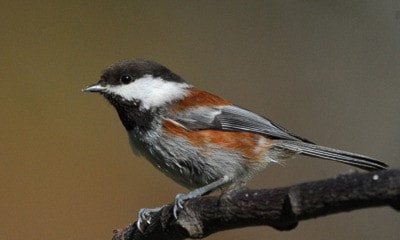At last we seem to have been treated to some spring-like weather which is being enjoyed by everyone including wildlife.
All of a sudden there are a multitude of birds singing their hearts out at the crack of dawn and they are a source of enjoyment to watch throughout the day.
For the past two years I have been hoping for some tenants in two bird boxes on my back fence and this year I finally have occupants in both boxes, one box has become home to a pair of chickadees, the other to violet green swallows.
I can't believe how captivating it has been watching these birds and a rewarding feeling once the swallows fledged and the chickadees will leave home any day now. To complete the backyard nursery I also have purple house finches nesting in my hedge, I have forgiven them for eating all the crab-apple buds and blossoms from my tree as they repay me with day long serenades.
Chestnut-backed chickadees are one of four species of chickadees found in British Columbia, the other three are black-capped, boreal and mountain chickadees. The black-capped chickadees are a bird of the wet coastal area and prefer to live along the edges of coniferous and deciduous forests, they have also adapted to urban areas and will willingly use nest boxes.
These chickadees do not migrate long distances, however they do make seasonal movement from lower lying areas to the higher elevations during the summer returning to sea level during the cold winter months.
Charismatic and charming little birds, chickadees are four to five inches tall and are very easy to identify; they have dark brownish black head caps, white cheeks and a black bib under their throat. Their breasts are pearly gray with chestnut-coloured backs and rumps and their wings are dark gray. Short-pointed beaks are designed for foraging insects; they are able to keep their balance by using their long tails as an anchor.
Acrobatic agility allows the chickadees to forage for food sources that most other birds cannot reach, they can often be seen hanging upside down as the glean bugs from the underside of leaves or pine needles.
These birds also use their feet to help retrieve a tasty morsel grabbing hold of the treat. Their foods of choice are insects and their eggs and larva, but will happily dine at a suet feeder.
Unlike the purple house finches, chickadees do not sing or whistle but do have an amazing repertoire of sounds that are often high-pitched and repetitive one being a sound that repeats their name "chickadee-dee-dee."
Chickadees are monogamous and renew their courtship each year, they also scout out potential nesting sites a year in advance, and I can attest that last spring my nesters were just looking before moving in this year!
Natural nest sites for these birds are often in rotting trees where they find a crevice or cavity, their open cup-shaped nests are lined with moss and covered with a blanket made from animal fur, especially the winter coats shed by deer, and can be a inch thick keeping the eggs warm.
• • •
Every year MARS reinforces the message about baby wildlife and what to do if you find any, often the message does not get through. Already we have six baby ducklings and two baby barred owls that fell from the nest.
Please call for advice before intervening with baby or any wildlife often the babies are hidden by the mother as she goes hunting or foraging for food. Ducklings and owls are often the lucky ones tending to be more resilient in rehab, but others like deer, water birds, kingfishers or other specialized species do not fare as well, all wildlife has the best chance of survival with their parents.
• • •
An update on the osprey is still positive for eventual release, and Klemtu was returned to his home in Klemtu thanks to Marine Harvest who transported the great horned owl along with Maj in a float plane.
• • •
Please look out for MARS displays during the coming weeks and months and we thank all those generous folks who have donated and supported our various functions to date. Please check our website at www.wingtips.org for more information on what to do if you find wildlife and for information on our annual general meeting on May 27.
• • •
To report injured or orphaned wildlife, please call 1-800-304-9968, for all other calls 250-337-2021.
Sandy Fairfield is the educational co-ordinator for the Mountainaire Avian Rescue Society (MARS). The MARS column appears every second Friday.



